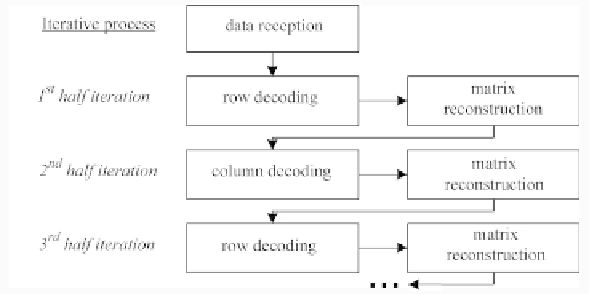Cryptography Reference
In-Depth Information
formance. Finally, recent studies have shown that decoding algorithms based on
belief propagation can be applied to linear codes in general [8.9].
8.5
Implantation of the Chase-Pyndiah algo-
rithm
The Fang-Battail algorithm requires the systematization of the parity matrix
which is a very costly operation. The Hartmann-Nazarov algorithm has been
implemented on
DSP
[8.6], but the precision necessary for the computation of
the metrics is too great for it to be envisaged to implement the decoder on a
reasonably sized
ASIC
. This is the reason why the Chase-Pyndiah algorithm is
the most commonly used decoding algorithm with weighted output for imple-
menting dedicated circuits [8.1], since by a judicious use of memories, it allows
turbo product codes architectures to be elaborated that are adapted to high-rate
transmissions [8.3].
Turbo decoding using the Chase-Pyndiah algorithm alternates weighted de-
coding of the rows and columns. This iterative process leads to the architecture
of Figure 8.7. Between each half-iteration is inserted a phase for reconstructing
the matrix in order to obtain the decoded word.
Figure 8.7 - Global architecture of a turbo product decoder.
Each half-iteration processor takes at its input the channel data as well as
the extrinsic values produced by the previous half-iteration. At the output,
the processor transfers the channel data (to ensure a
pipeline
operation of the
decoding chain), the hard decisions of the most probable codeword and the ex-
trinsic values calculated by the Chase-Pyndiah algorithm. The architecture of
the processor is illustrated in Figure 8.8. The FIFOs (
First-In/First-Out
)are
used to synchronize the input and output data of the SISO decoder which has
a certain latency. Small sized FIFOs are generally implemented by rows of D




